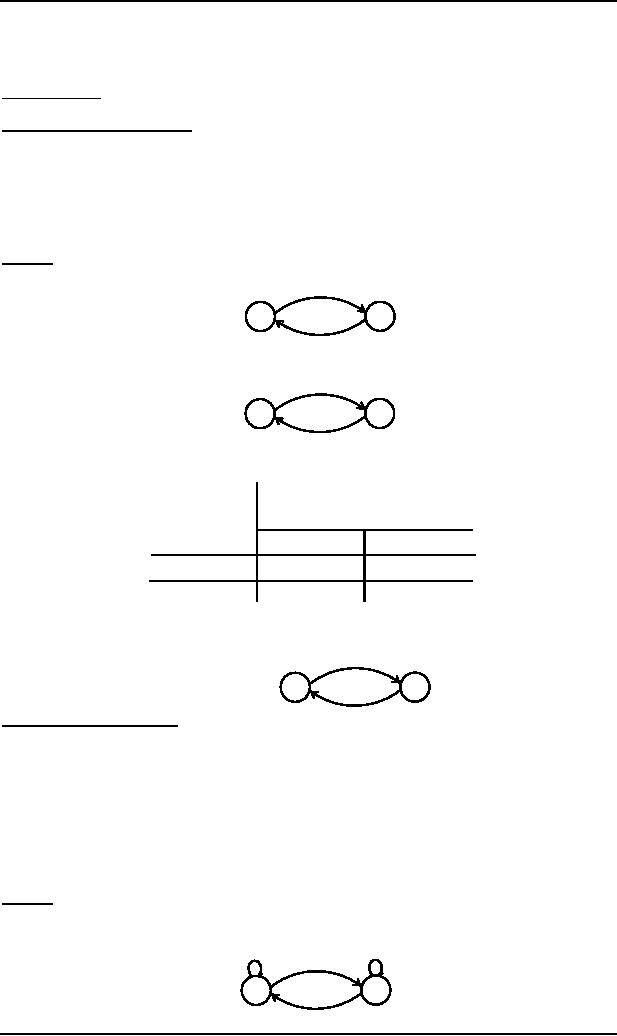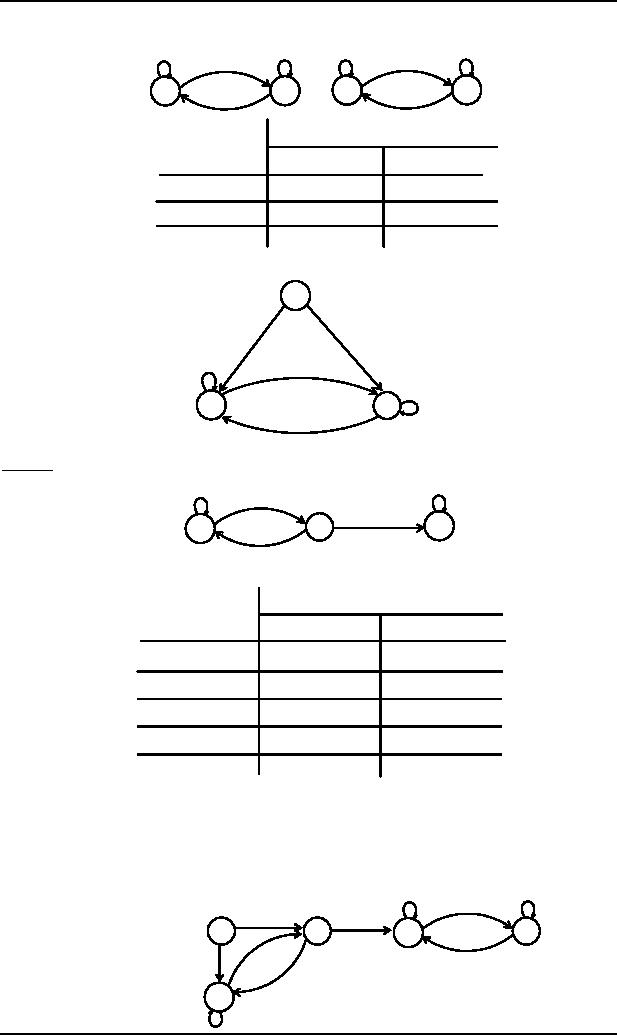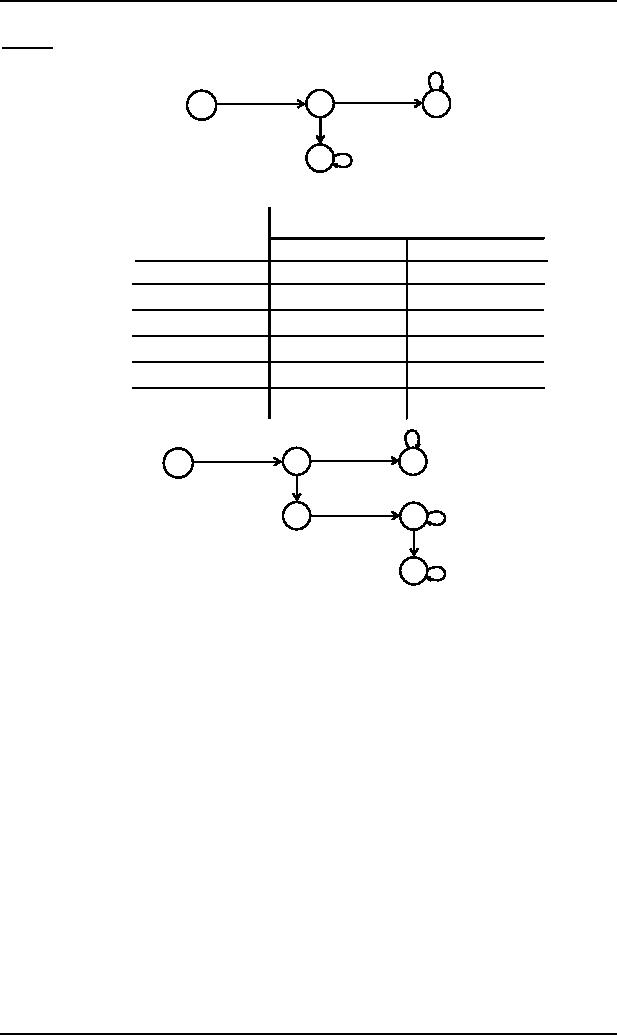 |
Closure of an FA |
| << Concatenation of FAs |
| Nondeterministic Finite Automaton, Converting an FA to an equivalent NFA >> |

Theory of
Automata
(CS402)
Theory of
Automata
Lecture
N0. 14
Reading
Material
Chapter
7
Introduction
to Computer Theory
Summary
Examples
of Kleene's theorem part III (method 1) continued
,Kleene's theorem part III (method 2:
Concatenation
of FAs), Examples of Kleene's
theorem part III(method 2:concatenation
FAs) continued,
Kleene's
theorem part III (method 3:closure of an
FA), examples of Kleene's
theorem part III(method 3:Closure
of an FA)
continued
Example
Let
r1 = ((a+b)(a+b))* and the corresponding FA1 be
a,b
x2
x1�
a,b
also
r2 = (a+b)((a+b)(a+b))* or ((a+b)(a+b))*(a+b)
and FA2 be
a,b
y1-
y2+
a,b
FA corresponding to
r1r2 can
be determined as
New
States after reading
Old
States
a
b
z1-∫(x1,y1)
(x2,y2) ∫z2
(x2,y2) ∫ z2
z2+∫(x2,y2)
(x1,y1) ∫z1
(x1,y1) ∫ z1
Hence
the required FA will be as
follows
a,b
y1-
y2+
a,b
Method3:
(Closure of an FA)
Building
an FA corresponding to r*, using
the FA corresponding to r.
It is to be
noted that if the given FA
already accepts the language
expressed by the closure of certain
RE, then
the
given FA is the required FA.
However the method, in other
cases, can be developed considering
the
following
examples
Closure of an FA, is
same as concatenation of an FA with
itself, except that the
initial state of the
required FA
is a
final state as well. Here
the initial state of given
FA, corresponds to the
initial state of required FA
and a
non final
state of the required FA as
well.
Example
Let r =
(a+b)*b and the
corresponding FA be
b
a
b
x1-
x2+
a
41

Theory of
Automata
(CS402)
then
the FA corresponding to r* may be
determined as under
b
b
a
a
b
b
x1-
x1-
x2+
x2+
a
a
New
States after reading
Old
States
a
b
Final
z1 �∫x1
x1∫z2
(x2,x1)∫ z3
Non-final
z2∫x1
x1∫z2
(x2,x1)∫z3
z3+∫(x2,x1)
x1∫z2
(x2,x1)∫z3
The
corresponding transition diagram may be as
under
z1�
a
b
b
a
z3+
z2
a
b
Example
Let r =
(a+b)*aa(a+b)* and the corresponding FA
be
a,b
b
a
a
y3+
y2
y1-
b
then
the FA corresponding to r* may
be determined as under
New
States after reading
Old
States
a
b
Final
z1�∫y1
y2∫z3
y1∫ z2
Non-Final
z2∫y1
y2∫z3
y1∫ z2
z3∫y2
(y3,y1)∫z4
y1∫ z2
z4+∫(y3,y1)
(y3 ,y1,y2)∫ z5
(y3,y1)∫ z4
z5+∫(y3,y1,y2)
(y3,y1 ,y2)∫z5
(y3,y1)∫ z4
The
corresponding transition diagram may be
a
b
a
a
a
z3
z1�
z5+
z4+
b
a
b
b
z2
z
b
42

Theory of
Automata
(CS402)
Example
Consider
the following FA, accepting
the language of strings with
b as
second letter
a,b
b
y2
y3+
y1-
a,b
a
y4
a,b
then
the FA corresponding to r* may
be determined as under
New
States after reading
Old
States
a
b
z1�∫y1
y2∫z2
y2∫ z2
z2∫y2
y4∫z3
(y3,y1)∫ z4
z3∫y4
y4∫z3
y4∫z3
z4+∫(y3,y1)
(y3 ,y1 ,y2)∫ z5
(y3 ,y1 ,y2)∫ z5
z5+∫(y3,y1,y2)
(y3,y1 ,y2 ,y4)∫ z6
(y3,y1,y2)∫ z5
z6∫(y1,y1 ,y2 ,y4)
(y1,y1 ,y2 ,y4)∫z6
(y1,y1 ,y2 ,y4)∫z6
a,b
The
corresponding transition diagram may be
a
z2
z3
z1�
a,b
b
a,b
z4+
z5+
b
a
a,b
z6+
43
Table of Contents:
- What does automata mean, Introduction to languages
- Kleene Star Closure, Recursive definition of languages
- Regular Expression, Recursive definition of Regular Expression
- Equivalent Regular Expressions
- Finite Automaton
- Equivalent FAs
- FA corresponding to finite languages
- Examples of TGs: accepting all strings
- Generalized Transition Graphs
- Nondeterminism, Kleene’s Theorem
- Proof(Kleene’s Theorem Part II)
- Kleene’s Theorem Part III
- Concatenation of FAs
- Closure of an FA
- Nondeterministic Finite Automaton, Converting an FA to an equivalent NFA
- NFA with Null String
- NFA and Kleene’s Theorem
- NFA corresponding to Concatenation of FAs
- Distinguishable strings and Indistinguishable strings
- Finite Automaton with output, Moore machine
- Mealy machine
- Equivalent machines
- Mealy machines in terms of sequential circuit
- Regular languages, Complement of a language
- Nonregular languages
- Pumping Lemma
- Pumping Lemma version II
- Pseudo theorem
- Decidability
- finiteness of a language
- Context Free Grammar (CFG), CFG terminologies
- Trees
- Polish Notation (o-o-o)
- Total language tree, Regular Grammar
- Null Production
- Chomsky Normal Form (CNF)
- A new format for FAs
- Nondeterministic PDA
- PDA corresponding to CFG
- Conversion form of PDA
- Conversion Form, Joints of the machine
- Row language, Nonterminals
- Non-Context-Free language, Pumping lemma for CFLs
- Decidablity, Parsing Techniques
- Turing machine